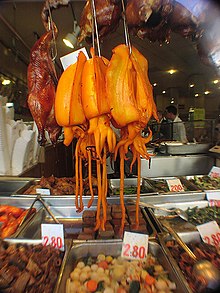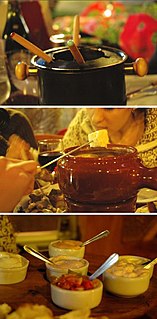
Teochew cuisine, also known as Chiuchow cuisine, Chaozhou cuisine or Chaoshan cuisine, originated from the Chaoshan region in the eastern part of China's Guangdong Province, which includes the cities of Chaozhou, Shantou and Jieyang. Teochew cuisine bears more similarities to that of Fujian cuisine, particularly Southern Min cuisine, due to the similarity of Chaoshan's and Fujian's culture, language, and their geographic proximity to each other. However, Teochew cuisine is also influenced by Cantonese cuisine in its style and technique.

Chinese cuisine is an important part of Chinese culture, which includes cuisine originating from the diverse regions of China, as well as from Chinese people in other parts of the world. Because of the Chinese diaspora and historical power of the country, Chinese cuisine has influenced many other cuisines in Asia, with modifications made to cater to local palates. Chinese food staples such as rice, soy sauce, noodles, tea, and tofu, and utensils such as chopsticks and the wok, can now be found worldwide.

Sweet and sour is a generic term that encompasses many styles of sauce, cuisine and cooking methods. It is commonly used in Asia and has been used in England since the Middle Ages. Sweet and sour remains popular in Europe and the Americas.

Singaporean cuisine is diverse and contains elements derived from several ethnic groups, as a result of its history as a seaport with a large immigrant population. Influences include the cuisines of the native Malays, the largest ethnic group, the Chinese and the third largest ethnic group, the Indians as well as Indonesian, Peranakan and Western traditions. Influences from other regions such as Sri Lanka, Thailand and the Middle East are also present.
The Pacific saury is a member of the family Scomberesocidae. This saury, which is a food source in some East Asian cuisines, is also known by the name mackerel pike.

Arròs negre is a Valencian and Catalan dish made with cuttlefish and rice, somewhat similar to seafood paella. Some call it paella negra, although it is traditionally not called a paella even though it is prepared in a similar manner.

Fish balls are a dish in China, notably popular in southern China, Hong Kong, Macau, as well as in parts of Southeast Asia, and among the overseas Chinese communities. They are made with fish paste and boiled in a soupy broth, or deep fried. They are also common in Nordic countries.

Char siu is a popular way to flavor and prepare barbecued pork in Cantonese cuisine. It is classified as a type of siu mei (燒味), Cantonese roasted meat.
The city of Ipoh is the administrative capital of the Malaysian state of Perak and is famous for its cuisine. Its food culture is driven by its majority Chinese population who are largely of Cantonese and Hakka descent. There is also excellent Malay and Indian food in Ipoh; the nasi kandar served by a prominent local Mamak stall is nicknamed nasi ganja due to its supposed addictive properties. Specialty foods from neighbouring towns are also available in Ipoh.

Rice vermicelli are a thin form of rice noodles. They are sometimes referred to as rice noodles or rice sticks, but they should not be confused with cellophane noodles, a different Asian type of vermicelli made from mung bean starch or rice starch rather than rice grains itself.

Siu mei, alternatively known as siu lap, is the generic name in Cantonese cuisine given to meats roasted on spits over an open fire or a huge wood burning rotisserie oven. It creates a unique, deep barbecue flavor and the roast is usually coated with a flavorful sauce before roasting. Siu mei is very popular in Hong Kong and Macau. After meetings held between the Food Hygiene Select Committee, the Markets and Abattoirs Select Committee and the Street Traders Select Committee on a topic of "Sale of Cooked Food, Siu Mei, and Lo Mei in Public Markets" in 1978, the Siu Mei shops officially entered into Hong Kong public markets. The public market is a popular place for ordinary citizens to buy Siu Mei.

A rice noodle roll is a Cantonese dish from southern China and Hong Kong, commonly served either as a snack, small meal or as a variety of dim sum. It is a thin crépe roll made from a wide strip of shahe fen, filled with shrimp, beef, vegetables, or other ingredients. Seasoned soy sauce – sometimes with siu mei drippings – is poured over the dish upon serving. When plain and made without filling, the rice noodle is also known as jyu cheung fan.

Japanese Chinese cuisine or Chūka is a style of Japanese cuisine served by nominally Chinese restaurants popularized in Japan in the late 19th century and more recent times. There is much confusion as both Japanese and Chinese reject that this food is the pure form of their own cuisine, however, it is clear this food is found primarily in Japan, though now it is re-popularized throughout Asia from Japan as "Japanese cuisine". This style of food is again different from modern Chinatown Chinese food in Japan, e.g. Yokohama Chinatown. The Shippoku style of cooking displays heavy influence from Chinese cuisine.

Guizhou cuisine, or Qian cuisine, consists of cooking traditions and dishes from Guizhou Province in southwestern China. Guizhou cuisine shares many features with Sichuan cuisine and Hunan cuisine, especially in bringing the sensation of spiciness and pungency. What makes Guizhou cuisine unique is the emphasis of a mixed sour-and-spicy taste, as compared to the numbing-and-hot sensation featured in Sichuan cuisine and the dry-hot taste featured in Hunan cuisine. There is an ancient local saying, "Without eating a sour dish for three days, people will stagger with weak legs". The saying reflects how Guizhou people love local dishes with a sour taste. The combination of sour and spicy flavours is also found in Shaanxi cuisine. Guizhou cuisine differs from Shaanxi cuisine in that it lacks the emphasis on the salty taste, which is a common trait found in most northern Chinese cuisines. In addition, the unique sourness featured in Guizhou cuisine comes from the local tradition of fermenting vegetables or grains, and not from using vinegar products.

Chifa is culinary tradition based on Chinese Cantonese elements fused with traditional Peruvian ingredients and traditions. Though originating in Peru, the Chifa tradition has spread to neighboring countries like Ecuador and Bolivia. Chinese immigrants came to Peru mainly from the southern province of Guangdong and particularly its capital city Guangzhou in the late 19th and early 20th centuries. They settled for the most part in the coast of Peru and the capital city of Lima. The term chifa is also used to describe a restaurant where this type of food is served. Chinese-Peruvian food has become one of the most popular types of food in Peru; there are thousands of Chifa restaurants across all districts of Lima and many more throughout other cities of Peru, with sometimes multiple independent restaurants operating in close proximity on a single city block.

Squid is eaten in many cuisines; in English, the culinary name calamari is often used for squid dishes. There are many ways to prepare and cook squid. Fried squid is common in the Mediterranean. In Lebanon, Syria and Armenia, it is served with tarator sauce. In New Zealand, Australia and South Africa, it is sold in fish and chip shops. In North America, fried squid is a staple in seafood restaurants. In Britain, it can be found in Mediterranean 'calamari' or Asian 'salt and pepper fried squid' forms in all kinds of establishments, often served as a bar snack, street food, or starter.

Cantonese Salted Fish is a traditional Chinese food originating from Guangdong province. It is a fish preserved or cured with salt, and was a staple food in Southern China. It historically earned the nickname of the "poor man's food", as its extreme saltiness is useful in adding variety to the simpler rice-based dinners. More recently it has become a popular cuisine in its own right.

Char kway teow, literally "stir-fried rice cake strips", is a popular noodle dish from Southeast Asia, notably in Malaysia, Singapore, Brunei and Indonesia. The dish is considered a national favourite in Malaysia and Singapore.

Hot pot, or hotpot, also known as steamboat, is a Chinese cooking method, prepared with a simmering pot of soup stock at the dining table, containing a variety of East Asian foodstuffs and ingredients. While the hot pot is kept simmering, ingredients are placed into the pot and are cooked at the table, in a manner similar to fondue. Typical hot pot dishes include thinly sliced meat, leaf vegetables, mushrooms, wontons, egg dumplings, tofu, and seafood. The cooked food is usually eaten with a dipping sauce.























